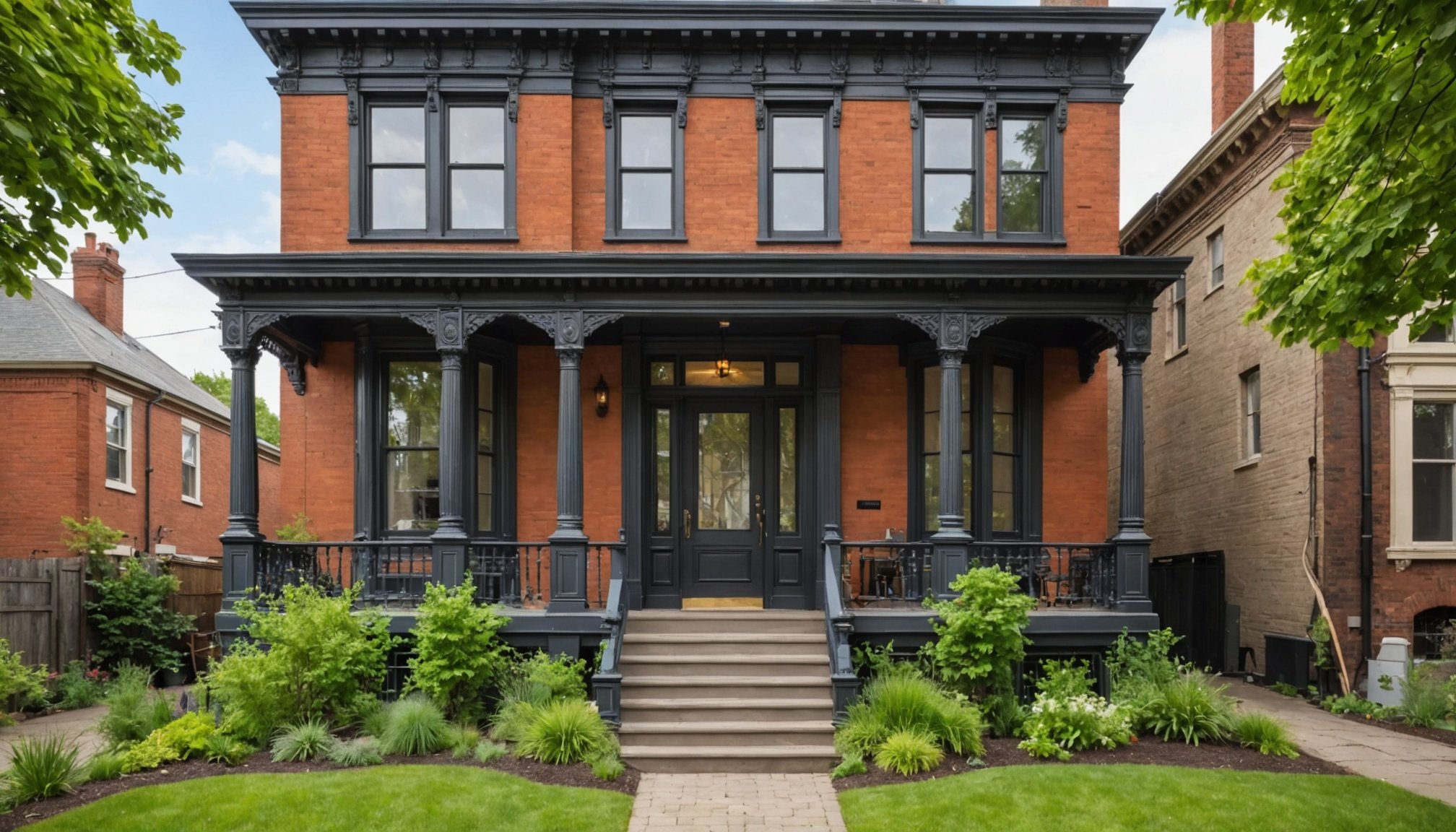Overview of Victorian Architecture and Sustainability
Victorian architecture, characterised by intricate ornamentation, steep gable roofs, and asymmetrical facades, holds historical significance as it dates back to the mid to late 19th century. This style reflects the societal values and technological advancements of the Industrial Revolution. Understanding its distinct characteristics is crucial when embarking on renovations to preserve its historic charm.
In recent years, the importance of sustainability in home renovations has become increasingly evident. For homeowners, implementing sustainable design in renovating Victorian architecture not only respects the environment but also ensures energy efficiency and long-term eco-friendly benefits. An emphasis on these practices has led to advancements in creating eco-friendly homes that harmonise with their local environments while retaining historical integrity.
Also read : Transforming victorian homes: chic strategies for sustainable energy efficiency
Historic home renovations require careful planning to incorporate sustainable features like insulation, energy-efficient appliances, and solar panels while maintaining the aesthetic appeal of the original design. Renovators can integrate eco-friendly practices such as using reclaimed wood and low-VOC finishes, significantly reducing the environmental footprint of these projects. Aligning with modern sustainability standards, these practices underscore a commitment to conserving both the architectural heritage and natural resources.
Eco-Friendly Renovation Techniques
Incorporating sustainable renovation techniques into the restoration of Victorian homes brings numerous benefits. One key area is upgrading insulation, which can be achieved through green building materials such as recycled fibreglass or cellulose. These materials maintain the home’s original character while significantly reducing energy loss, thus promoting eco-friendly improvements.
Also to discover : Sustainable Solutions for Bustling Cities: A Comprehensive Guide to Low-Impact Development Strategies
Energy-efficient windows are another critical component of sustainable renovation. They help to regulate indoor temperatures by minimizing heat exchange with the exterior. This not only lowers heating and cooling costs but also enhances the comfort of eco-friendly homes. The use of these windows is a prudent eco-friendly improvement that preserves the elegant appearance of Victorian façades.
To further enhance sustainability, incorporating renewable energy sources like solar panels can greatly reduce a home’s carbon footprint. Though installation may require an initial investment, the long-term savings on utility bills can outweigh these costs over time. Solar energy systems can be tastefully integrated into the roof design, ensuring that the architectural integrity of the Victorian home is retained. Hence, by combining effective insulation, energy-efficient windows, and renewable energy, homeowners can significantly contribute to sustainable living while preserving their property’s heritage.
Innovative Materials for Renovating Victorian Homes
Incorporating sustainable materials into Victorian home renovations adds both environmental and aesthetic value. Using reclaimed materials like wood not only provides an authentic look but also reduces waste and resource use. Reclaimed wood can be integrated into flooring, paneling, or trims, preserving the historical charm while supporting eco-friendly construction practices.
Reclaimed materials
Reclaimed materials also contribute to eco-friendly construction by offering a rich story and unique appearance due to their history. This sustainable approach demonstrates a commitment to reducing the environmental impact of renovations.
Low-VOC paints and finishes
Choosing low-VOC (Volatile Organic Compound) paints and finishes is crucial for maintaining healthy indoor air quality. These products drastically reduce harmful emissions compared to traditional options, improving overall living conditions while still offering a wide range of colours and finishes suitable for Victorian homes.
Sustainable flooring options
Sustainable flooring options include materials like bamboo or cork, which are rapidly renewable and durable. They maintain the home’s historical appeal while providing a modern eco-conscious alternative to conventional flooring. Each choice contributes to creating an environmentally responsible and heritage-conscious renovation, ensuring a harmonious balance between sustainability and architectural preservation.
Case Studies of Successful Eco-Friendly Renovations
Exploring renovation case studies offers valuable insights into transforming Victorian homes with sustainable techniques. These successful projects showcase the harmonious blend of history and modern eco-consciousness. One renowned example is the restoration of a Victorian row house in London, where renovators combined eco-friendly improvements like solar panels and reclaimed wood interiors. This project retained the historical façade while significantly enhancing energy efficiency, demonstrating how eco-friendly design examples effectively preserve architectural heritage.
Before-and-after comparisons illustrate the dramatic impact of these renovations. Upgraded insulation and energy-efficient windows not only reduced energy costs dramatically but also improved the indoor climate. Homeowners noted a 30% reduction in heating expenses, underscoring the economic viability of sustainable renovation techniques.
Lessons learned from these projects emphasize the importance of planning and material choice. By prioritizing sustainable materials and integrating advanced design principles, historical integrity can be maintained without sacrificing environmental responsibility. Key takeaways highlight that while initial costs may be higher, long-term savings and reduced environmental impact make eco-friendly renovations a worthwhile investment. These studies inspire confidence and encourage exploration of sustainable options tailored to individual needs.
Expert Tips for Eco-Friendly Renovations
Navigating the realm of eco-friendly renovations can be daunting, yet expert advice can ease the process. Professionals in sustainable architecture emphasise the value of comprehensive planning. Renovation tips from experts frequently advise prioritising areas that offer the most significant environmental impact, such as improving energy efficiency with modern insulation or incorporating eco-friendly materials like reclaimed wood.
Common pitfalls to avoid include neglecting the building’s structural history. Mistakes such as incompatible materials or improper installations can jeopardise a home’s historical integrity. Experts recommend consulting specialists in historical architecture to ensure sustainable practices do not compromise traditional aesthetics. This careful approach enables modern amenities to be woven seamlessly into the existing fabric of Victorian homes, marrying innovation with heritage.
A frequent piece of advice is to strike a balance between sustainability and tradition. Incorporating contemporary technologies like energy-efficient systems can significantly enhance long-term savings without undervaluing a home’s historic charm. Experts also remind homeowners to investigate incentives or grants for sustainable renovations. These financial tools can alleviate initial costs, making green renovation endeavours more accessible and aligning home projects with today’s environmental standards.
Cost Implications and Financial Benefits
Embarking on sustainable renovations often raises concerns about renovation costs, but understanding the financial landscape may ease such worries. While the upfront investment in green features is generally higher, significant long-term savings offset these costs, particularly through reduced utility bills. Implementing energy-efficient systems like solar panels can notably decrease electricity expenses, creating a positive ripple effect on household budgets.
Budget-friendly solutions also exist, even within the realm of eco-conscious upgrades. For instance, replacing traditional lighting with LED options provides immediate reductions in energy consumption, leading to noticeable savings over time. Moreover, incorporating reclaimed materials reduces initial material expenses while maintaining aesthetic appeal, enhancing return on investment.
In addition to reduced utility bills, homeowners might qualify for various incentives and grants designed to support sustainable renovations. These financial tools differ by region but often encompass tax credits, rebates, or even government-backed loans tailored for ecological improvements. By leveraging these opportunities, renovators can significantly mitigate initial expenditures, making eco-friendly ambitions more economically feasible.
Thus, while initial investments may be intimidating, exploring available financial aids and focusing on long-term benefits fosters both financial prudence and environmental stewardship.
Resources for Sourcing Sustainable Materials
Finding sustainable resources is crucial when undertaking an eco-friendly renovation. Trusted suppliers for eco-friendly building materials ensure that projects remain environmentally conscious while maintaining high-quality standards. Numerous suppliers specialise in providing renovation materials such as reclaimed wood and low-VOC paints, catering specifically to sustainable building needs.
Online platforms like Reclaimed Wood Exchange provide convenient access to unique, eco-conscious options worldwide. These marketplaces offer an array of materials, allowing renovators to source everything from vintage floorboards to period-appropriate fixtures seamlessly. Engaging with such platforms demonstrates a commitment to sustainability and preserves the historical essence of Victorian architecture.
Access to local resources and community programs further supports the journey toward sustainable renovations. Many regions have community-driven initiatives encouraging homeowners to choose eco-friendly suppliers. These programs often connect individuals to local businesses specialising in green construction materials and advice, fostering a sense of community while supporting local economies.
Participation in these networks allows renovators to tap into valuable knowledge and resources, reducing their environmental impact. Leveraging these strategic partnerships helps homeowners align their projects with modern environmental standards while preserving the heritage of their properties.











